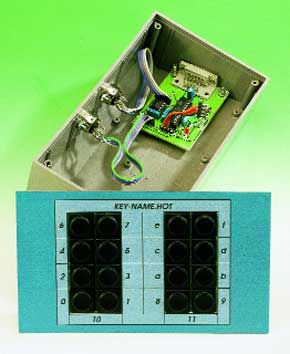HotKeys keyboard (2)
construction, software and a few tips

This is a MEMBER ONLY article. You need a subscription to read this article.
- Unlimited access to online Member Only articles
- 3 new editions Elektor Magazine (digital)
- More than 5000 Gerber files
- 20% member discount on e-books (at elektor.com)
- 10% member discount on Products (at elektor.com)
Available from €5.33 per month.
What is Members Only
Elektor is committed to providing high-quality content on electronics, catering to tens of thousands of paying members. As part of this commitment, Elektor has launched Premium, an initiative that offers exclusive online articles to members sometimes even before they appear in the magazine.
Every day, members can access in-depth articles that showcase the best of Elektor's premium content.
This initiative aims to reward members with early access. Once logged in, members can easily enjoy this exclusive content and engage in discussions about featured projects. While Premium adds to the existing resources available, Elektor will continue to provide a wealth of free information.
Join the Elektor community today to take advantage of Premium and other benefits!
Materials
Gerber file
CAM/CAD data for the PCB referred to in this article is available as a Gerber file. Elektor GREEN and GOLD members can exclusively download these files for free as part of their membership. Gerber files allow a PCB to be produced on an appropriate device available locally, or through an online PCB manufacturing service.
Elektor recommends the Elektor PCB Service service from its business partner Eurocircuits or AISLER as the best services for its own prototypes and volume production.
The use of our Gerber files is provided under a modified Creative Commons license. Creative Commons offers authors, scientists, educators and other creatives the freedom to handle their copyright in a more free way without losing their ownership.
Component list
R1,R2,R4 = 1k?
R3 = 330?
R5,R6,R10,R14,R18 = 10k?
R7,R15 = 2k?2
R8,R16 = 3k?9
R9,R17 = 6k?8
R11,R19 = 15k?
R12,R20 = 27k?
R13,R21 = 47k?
Capacitors:
C1,C3 = 100nF
C2 = 10µF 16V radial
Semiconductors:
D1,D2 = BAT85
D3 = LED, red, high efficiency
D4 = LED, green, high efficiency
T1 = BC557
IC1 = MAX323CPA or MAX323EPA
IC2 = ST62T60 (programmed, order code 002006-41)
Miscellaneous:
K1,K4 = 5-way SIL pinheader
K2 = 9-way sub-D socket (female), PCB mount
K3,K5 = 4-way SIL pinheader
S1-S16 = pushbutton, e.g. Marquardt (Conrad Electronic o/n 70 68 92-55, with cap 70 08 60-55)
Bz1 = 5-V piezo-ceramic buzzer (passive)
X1 = 8 MHz ceramic resonator
5-way DIN plug, pins arranged at 180 degrees
5-way DIN socket, receptacles arranged at 180 degrees
10 cm 5-way flatcable



Discussion (0 comments)